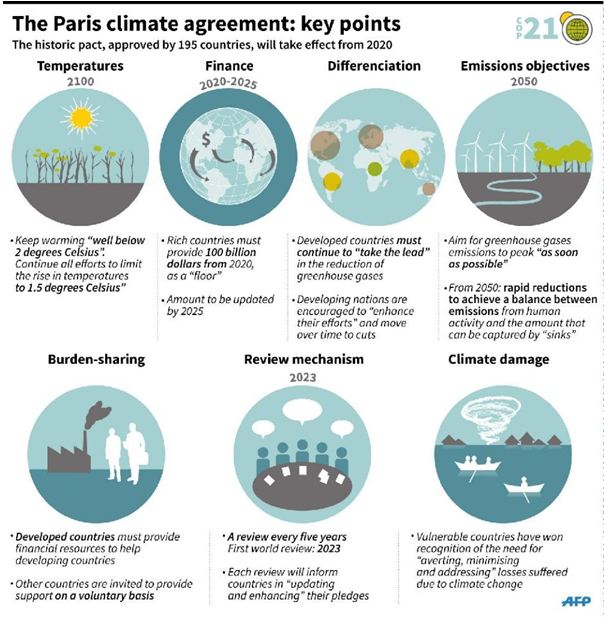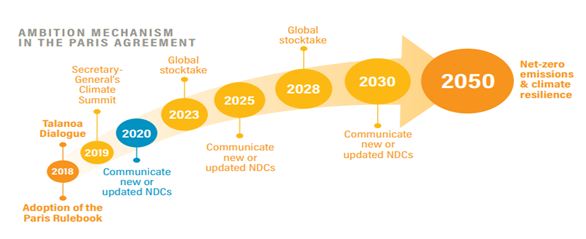ForumIAS announcing GS Foundation Program for UPSC CSE 2025-26 from 19 April. Click Here for more information.
ForumIAS Answer Writing Focus Group (AWFG) for Mains 2024 commencing from 24th June 2024. The Entrance Test for the program will be held on 28th April 2024 at 9 AM. To know more about the program visit: https://forumias.com/blog/awfg2024
Context: 196 countries at COP24, Katowice have agreed on a rulebook to implement the 2015 Paris Agreement.
Background of Pro-active Climate negotiations
- The problem of climate change was brought to light at an international level by the first Intergovernmental Panel on Climate Change (IPCC) Assessment Report in 1990 which highlighted the issue as a subject in need of a political platform.
- Consequently, in United Nations Framework Convention on Climate Change (UNFCCC) was adopted in 1992which sets the framework for negotiating specific agreements, such as the Kyoto Protocol and the Paris Agreement.
1st agreement on Climate Change- The Kyoto protocol
In 1997, the Kyoto Protocol was adopted which aimed to achieve a legally binding emissions reduction by industrialised countries.
Key elements of Kyoto Protocol:
1.Target-
- Reduction of collective Greenhouse gas (GHG) emissions by 5.2% from the 1990 level by 2012. This is known as the “first commitment period”
- Second commitment period (2013-2020) to reduce emissions by 18% was adopted by the Doha Amendment (2012)
2.Approach: Equity and Common but differentiated responsibilities and respective capabilities (CBDR)- Legally binding targets for 39 developed countries. No legally binding targets for developing countries.
3.Mechanisms:
a) Clean Development mechanism: It involves investment in emission reduction or removal enhancement projects in developing countries that contribute to their sustainable development
b) Joint implementation: It enables developed countries to carry out emission reduction or removal enhancement projects in other developed countries.
c)Emission trading: It allows countries that have emission units (carbon dioxide) to spare (emissions permitted them but not “used”) to sell this excess capacity to countries that are over their targets.
Failures of Kyoto Protocol:
- Exclusion of developing countries from emissions reduction targets notably Brazil, South Africa, India and China (BASIC) made the Kyoto Protocol inequitable.
- Disagreement on the strategies to achieve emissions reduction targets and poorly designed mechanisms which did not effectively reduced GHG emissions.
- A very low number of member countries ratified– For example: USA never ratified
- Poor compliance by member countries- For example: Japan failed to meet their obligations, and chose not to participate in the second commitment period.
- Top down approach– The Kyoto Protocol had a top-down approach as it had legally binding targets providing very less flexibility to member countries
2nd Agreement on Climate Change: Paris Agreement
- As the Kyoto Protocol ultimately failed to induce significant emission reductions on a global scale, the Paris Agreement was adopted at the COP21 held in Paris.
- It aims to strengthen the global response to the threat of climate change and specifies long-term goals regarding global average temperatures, adaptation to climate change and finance flows
Key differences between Kyoto Protocol and Paris Agreement
Key aspects of Paris agreement
Goals:
- Temperature:hold warming below 2°C above pre-industrial levels with effective efforts to limit warming to 1.5°C
- Adaptation:Increasing the ability to adapt to the adverse impacts of climate change and foster climate resilience and low greenhouse gas emissions development
- Low Emission Finance flows:Making finance flows consistent with a pathway towards low greenhouse gas emissions and climate-resilient development
Approach:
Intended Nationally Determined Targets: Unlike, the Kyoto Protocol, the Paris Agreement gives flexibility to both developed and developing countries to determine their own targets. The INDCs setout each country’s plan for addressing climate change, including a target for reducing GHG emissions, and how the countries intend to achieve that target.
Development after Paris agreement
- COP22: The COP22 was held in Marrakech, Morocco in 2016 to discuss and implement plans about combatting climate change in the lines of Paris Agreement
- COP23: The COP 23 was held in Bonn, Germany in 2017. A major outcome of the COP was the Talanoa Dialogue. It is an inclusive and participatory process that allows countries, and non-Party stakeholders, to share experiences and showcase best practices in order to urgently raise ambition in nationally determined contributions (NDCs).
- COP 24: The COP 24 was held in Katowice, Poland in 2018. The biggest achievement was the adoption of the Paris Rulebook which establishes the rules and processes needed to provide the operational guidance for fulfilling the ambition of the Paris Agreement.
It includes details on several fronts:
- How the emissions from every country should be measured
- How these measurements should be reported and verified
- Kinds of financial flows – loans, concessions, grants-that can be classified as climate finance,
- The manner in which financial flows should be accounted
- the information that every country needs to provide regarding their climate actions
- The mechanisms for diffusion of appropriate technologies to developing countries
- How collective efforts will be reviewed, leading to scaled-up actions and support every five years (Global Stocktake)
Persistent Issues and Challenges with Paris agreement
1.Enforcement Issues:
- As the Paris agreement is not legally binding, there are no penalties to be imposed in case of non-compliance. Further, it lacks mechanism to ensure accountability and verify claims of carbon reductions
2.Targets and commitments:
- Environmentalists have raised concerns that the 2°C target of limiting global warming is inadequate to address the current pace of climate change and curtail sea-level rising which will impact the island states most.
- Also, the Paris Rulebook falls short of the radical action to address climate change and does not include any firm commitments by countries to reduce carbon emissions despite the recent report of U.N. Intergovernmental Panel on Climate Change (IPCC)
1. The report states that the world has become 1°C warmer because of human activities, causing greater frequency of extremes and obstruction to the normal functioning of ecosystems.
2. Notes that limiting global warming at 1.5 C above preindustrial levels rather than 2 degrees can soften climate impacts
3. Warns that the world has to reduce net carbon emissions by 45% by 2030 and bring them down to zero by 2055, if it wanted to keep the planet liveable in the 21st century.
3.Mitigation Centric Approach:
- Critics have opined that the Paris agreement through its rulebook has adopted primarily a mitigation-centric approach and the urgent adaptation needs of the developing countries are not prioritised.
4.Common but differentiated responsibilities
- Egypt, Africa group and the association of small island states have alleged the principle of common but differentiated responsibilities has been compromised in the Paris rulebook in its global stocktake and thus the burden to climate change has been put inequitably on the developed and developing nations who lack both technology and finance.
5.Methodolgy:
- The countries that have ratified the Paris Agreement are required to set a target for emissions reduction through their INDCs, however, there is no threshold or minimum emissions reduction it must achieve.
- The key question of how countries will step up their targets on cutting emissions also remains unaddressed by the Paris rulebook.
6.Finance:
- According to Centre for Science and Environment (CSE), Delhi the rulebook does not include provisions to assess the reporting of financial grants or review whether it is adequate
- Under the Paris Rulebook, countries are allowed to count all sorts of non-grant instruments, including commercial loans, as ‘climate finance’. This raises concerns over a poor country repaying debt on commercial loans provided as climate finance. Further, there are no proper rules for accounting when the loans are repaid.
- According to critics, rulebook does not put adequate emphasis on the adaptation finance needed for developing countries and ‘loss and damage’ finance which is crucial for poor and island nations
- Further, the rulebook does not incorporate any mechanism to examine the utilization of climate finance flowing to developing nations.
7.Technology:
- Critics allege that the Paris climate agreement inadequately address the pressing need of developing environment-friendly technology and transfer of technology to ill-equipped nations.
8.Market mechanism on carbon:
- A major issue riddling climate negotiation has been carbon credit mechanism which witnessed a major setback after most of the developed nations did not commit to the 2nd period of Kyoto Protocol which resulted in accumulation of large amount of unsold carbon credits. A key element of the rulebook was supposed to be the governance framework for a new carbon market. However, consensus on carbon credit market could not be reached due to contradicting views between developing nations like Brazil and developed nations
- Development Dilemma:
- Developing countries face the dual challenge of reconciling their rapid fuel-based economic growth with a pressing need to address climate change. This raises concerns over the successful implementation of the Paris agreement.
10.Exclusion of Private players:
- The climate change conferences do not incorporate corporate players like Facebook or Google who have huge potential to help fund projects and take part in mass awareness.
- Consumer Behaviour
- A major challenge in successful implementation of any climate change agreements is tweaking the consumer behaviour. For example; for switching to low-carbon economy it is important to nudge people to adopt energy efficient behaviour
- Implementation:
- Critics have raised doubts about effective implementation of the Paris Agreement. This is because the UNFCCC has become primarily a platform to collect and synthesise information and a forum to discuss and debate but lacks tools to drive global collective action against climate change.
- Withdrawal of USA
- Climate change negotiations have more of an economic negotiation rather than collaborative environmental initiative. This can be clearly seen from US’s decision to withdraw from Paris agreement owing to vested economic interests.
1. India has welcomed the Paris Rulebook and stated that it addresses the concerns of all stakeholders and provides roadmap for effective implementation of the Paris Agreement.
2. However, India also opined that provisions of global stocktake did not adequately reflect the principles of equity and differentiated responsibilities.
3. India has been largely satisfied with the finance aspect dealt by the Rulebook-primarily the transparency in climate finance flows
4. However, a certain section in India has advocated that India being the ‘face’ of developing nations should have bargained on the quantum of climate finance
Conclusion:
- Multi-level engagement: Non-state actors such as business and financial organisations, cities and other subnational governments, intergovernmental organisations and non-governmental organisations should be actively engaged for implementing climate change agreements
- Cooperation:Dissenting voices and their concerns must be assuaged and subsequently incorporated into this concerted effort to deal with climate change through effective and meaningful bilateral and regional engagements
- Lessons from Montreal: Lessons should be learnt from the successful Montreal Protocol which shows one of the finest examples of international collaboration to address environmental concerns
- Domestic Policies: It is important for governments to align domestic policies with respective INDCs in order to effectively implement the Paris agreement. For example: India’s Zero Defect Zero Effect Policy which aims at ensuring zero environmental effect through manufacturing process.
- Sectoral Convergence: The focus should not only be on fossil-fuel based industries but Governments will need to scale up climate action in the agriculture, forestry and other land-use sectors.
- SDGs and Paris Climate Deal:It is important to align and intertwine the sustainable development goals (SDGs) with the Paris dealfor an efficient method to reduce carbon emissions. For example: Ethiopia addresses both climate and development challenges, with changes to agricultural practices, replanting forests and introducing low-carbon technologies for its infrastructure.
- R&D:Research and development in new technology (such as carbon capture and storage, negative emissions technologies and electricity storage) is crucial for a better transition to low carbon economies
- Role of Individuals: The most important dimension for success of any environmental policy is the individual. Thus, it is important to raise awareness and educate people about climate change- the biggest challenge of 21st








